A look into my past (from a ham's prospective)....
Copyright 2000 Jim Leighty
What else, but "the early years":
I was born to Nell Alcorn Leighty and Charles Dwight Leighty. They married late
due to the depression. When mom was 39, I became their last chance to have a child. It was to be a tremendous advantage
for me to be an "only child". One might wonder why later at age 12 I had a Collins 75A1 receiver, at 13 I had
a Johnson Viking II, at 15 I had a 54 foot crank-up tower, etc. Mom and dad wanted me not to have to suffer all
the problems they had during the depression. I was quite fortunate to have such good and loving parents.
When I was two, I needed glasses to correct my crossed eyes. 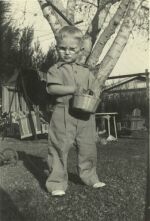 This was part of
a formula for a person who might be classifed today as a "nerd". When I was five, a characterature was
drawn of me. I have it today. I am shown with BIG glasses and a calculus book under my arm. Funny thing, when I
took my first calculus class, I knew that I would always love math.
This was part of
a formula for a person who might be classifed today as a "nerd". When I was five, a characterature was
drawn of me. I have it today. I am shown with BIG glasses and a calculus book under my arm. Funny thing, when I
took my first calculus class, I knew that I would always love math.
I got interested in shortwave radio and becoming a ham when I was 10 years old.
My father had a friend who knew Gloyd McClellan, W6VPD; he introduce me to "Mac". Mac was an engineer at the KMPC transmitter in North Hollywood. I rode my bicycle over to KMPC once a week and "helped"
Mac. I was a little guy, and I could climb into the air ducts which cooled the 50,000 watt transmitter. KMPC was
10KW in the night (directional) and 50KW omni days. Just before dawn I helped clean the ducts feeding air to the
air cooled transmitter. Many AM transmitters were water-cooled, but KMPC was air-cooled. I remember the routine
that was used to switch from low power to high power. There were two complete transmitters, with control stations
about 25 feet apart. The cue from the studio (in Hollywood) to switch power was "this is KMPC Los Angeles
serving Southern California best". Mac would 1) turn off the 10KW transmitter, 2) hit a switch which would
transfer the antenna system from the directional (3 tower) mode to omni (one tower) and switch between transmitters,
3) run the twenty five feet between control consoles, 4) turn on the 50KW transmitter, and 5) push a button on
the control console that transmitted a 1000 cycle audio tone. The studio, hearing the tone, new that they were
back on the air. They would they say that they were KMPC 710 Los Angeles 50,000 watts. Funny thing, they never
said they were KMPC 10,000 watts when they reduced power at night! KMPC was quite a popular station in those days.
I remember when I first spoke on the ham radio. I rode my bicycle over to Mac's
house. He was just leaving. He had just started a conversation from his 75 meter AM mobile. He shoved the hand
microphone in my face and said to say hello. I was REALLY petrified!. I said something, but I still remember how
scared I was to speak into the microphone. Obviously, that changed.
When I was 10, my parents bought me a shortwave receiver. It was a used Hallicrafters
S-20R. I tuned the ham and shortwave broadcast bands endlessly. I knew the call letters of most of the local hams.
There was Frank Creswell, W6HK (Hot Kilowatt). Frank was in aerospace doing secret stuff (we know not that he worked
on rocket planes, and frequently went to Edwards / Muroc dry lake). I bought a Callbook Magazine (I still have
it). I went through all the California listings (about 30,000 then), and marked all the ones who lived close to
me in Van Nuys. I found that W6HK lived on Magnolia just east of me. I rode my bicycle over to his house, knocked
on his door, and was taken to his "shack" in the middle of the back yard. I was impressed. It was dark,
dusty, had a couch to sit on, and a big desk with lots of radios. I made many trips over to the W6HK shack to sit
and watch Frank Creswell operate. I helped too. I took loads of empty beer bottles from the shack up to the trash
cans in the front of his residence. I remember one thing that impressed me. When the telephone rang, there was
no bell to sound; instead, a 25 watt lightbulb flashed. Frank had a tower and a 10 meter beam behind the shack.
But, he had a big signal on 75 meters phone (3905 Kcs). He always claimed that he only ran 90 watts - but stilled
used Hot Kilowatt as the phonetics for his call.
In those days, I rode my bicycle all over town and knocked on ham's doors. It
was no big deal back in the 50's. It seemed that I always met someone who welcomed me and brought me inside to
their rig. Those were more innocent days.
Another ham friend back then was W6 Henry Ida Charlie (this was before current
day phonetics). Late in the evening, when the 75 meter folks typically got a bit rowdy. W6HIC would announce his
call as W6- "hic", and say "...and I hope I didn't slop it on you". Funny stuff! I just had
to get my license.
I sent Morse code to myself, but that just didn't seem to work well. It was not
until I was 12 and went to Van Nuys Junior High School that I finally got my license. The first thing I found at
Van Nuys Junior High was that a math teacher, Henry Quinley, W6ZFW, was starting a ham radio club. I learned, also,
that one could buy records that taught one Morse code. But to get them, I had to ride my bicycle to Burbank (Valley
Electronics). I did so. My folks told me I could only buy one at a time, and had to learn one before I could get
another. These 78 RPM records cost one dollar apiece and were easily broken. Well, with these records I learned
the code and was able to pass my Novice test in just one month. I waited, and in October, I became WN6UJX.
Mac took me to Henry Radio in West Los Angeles. We bought an Elmac A-54H transmitter
from Frank Cuavas. I was on the air!
 Eighty CW was my favorite band. There I met Steve Jensen, WN6RHM. Later I met
Paul Signorelli, K6CHR (pictured - he's now W0RW). These were good times. I spent a lot of time on the air. I was thrilled to be
able to work Nevada. My code speed advanced only because I spent so much time on the air. In April of 1953 I passed
my General license. One of my first contacts was with Frank, W6AOR. He and his wife (W6YRL) lived near Burbank
Blvd and Woodman Avenue. I visited them. Their operating position was a classic - it looked even better than the
KMPC transmitter (and that says a bunch).
Eighty CW was my favorite band. There I met Steve Jensen, WN6RHM. Later I met
Paul Signorelli, K6CHR (pictured - he's now W0RW). These were good times. I spent a lot of time on the air. I was thrilled to be
able to work Nevada. My code speed advanced only because I spent so much time on the air. In April of 1953 I passed
my General license. One of my first contacts was with Frank, W6AOR. He and his wife (W6YRL) lived near Burbank
Blvd and Woodman Avenue. I visited them. Their operating position was a classic - it looked even better than the
KMPC transmitter (and that says a bunch).
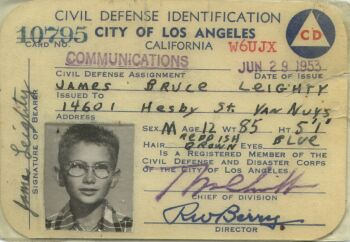 I became a member of Los Angeles Civil Defense. In time I joined RACES (Radio Amateur Civil Emergency Services) and met many new friends. I was lucky to have adult friends like Jim Parker, K6HKI and Bill Swain, W6CYS (SK), who drove me to meetings in downtown LA and took me on transmitter hunts.
I became a member of Los Angeles Civil Defense. In time I joined RACES (Radio Amateur Civil Emergency Services) and met many new friends. I was lucky to have adult friends like Jim Parker, K6HKI and Bill Swain, W6CYS (SK), who drove me to meetings in downtown LA and took me on transmitter hunts.
In 1954, the Van Nuys Junior High Amateur Radio Club applied for and received
a "club station" license, with Henry Quinly as trustee. We were now K6DQD - "Doctor Quinley's Demons".
The school bought us quite a nice station. And, we were front page news in the San Fernando Valley News and Green
Sheet (now the Los Angeles Daily News). I'm in the picture with some good folks including Mark Weiss (K6PBI - now
K6FG), Jim Forgette, Dean Cohen (WA6KYC), , Iran Ausley (K6BMD), Richard Steinmetz, Steven Bensussan, Steven (the
woodshop teacher's son) and our leader Henry Quinley (W6ZFW). Any help with other names would be appreciated.
This picture was on page one of what we called the San Fernando Valley newspaper:
the " Valley Green Sheet". That's me in the upper left (today we call that nurdy).
|
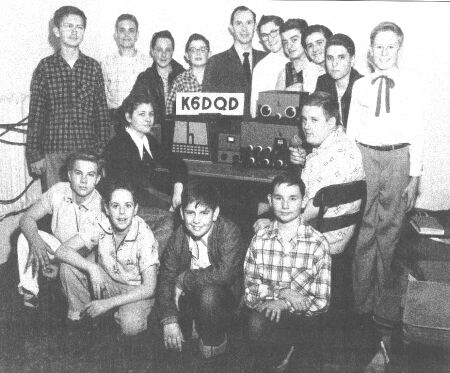
|
Mr. Quinley was indeed a mentor. He wanted me to go to UCLA, where he had gone.
I think he was pleased when, in 1963, he received an invitation to attend graduation ceremonies when I received
my Bachelor's degree in Engineering from UCLA.
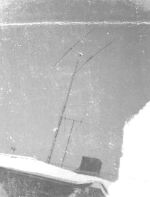 In those days I was quite active. First, my dad and I built a ten meter beam
(wood supports) that was mounted on our rooftop.
In those days I was quite active. First, my dad and I built a ten meter beam
(wood supports) that was mounted on our rooftop. 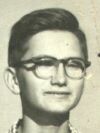 In 1956 we added a 54 foot crank-up tower (pictured) to the back of the house,
with a two element tri-band beam on top. This was probably one of the first commercial tribanders. I worked lots
of DX with that antenna. I was active for sure. A teacher once dropped my grade in class saying "you are spending
too much time on your ham radios". I got to take English Literature over. It probably did me good - since
I still think about the "ode to a grecian urn". It put things in prospective.
In 1956 we added a 54 foot crank-up tower (pictured) to the back of the house,
with a two element tri-band beam on top. This was probably one of the first commercial tribanders. I worked lots
of DX with that antenna. I was active for sure. A teacher once dropped my grade in class saying "you are spending
too much time on your ham radios". I got to take English Literature over. It probably did me good - since
I still think about the "ode to a grecian urn". It put things in prospective.
I loved to go on Transmitter hunts. Before I could drive, good ham friends like
Bill Swain (W6CYS-SK, Jim Parker (K6HKI) and Helen Signorelli (K6KUP) did the driving. When I was sixteen, I was
mobile in my red and white 1949 chevy (my friends referred to it as a "Tijuana taxi" because of the paint
job). My good friend, Jim Forgette, was a real T-hunt afficionado too. Jim (see the Van Nuys High Radio club picture
- he is the one at the microphone) never got his license. He was best man at my wedding(s) and today I still retain
good memories of his mom and dad. On two, we had Gonset Communicators and the favored frequency was 145.35 Megacycles;
we were "35ers". Again, our group was a bit rowdy and unusual. Once in a while I still see Lee Norris
(K6CJE), Ken Holland (K6TOX), Dick Ulrick (K6KCY), Emmett Dunlap (WA6COT) and e-mail Paul Signorelli (K6CHR/W0RW) and get checked for "old fingers" by Tom Vestal (W6NIN).
They became "76ers" with the advent of FM (146.76 Megacycles). And we were members of the SSSS (I still
have my card). I remember that once W6ZJU, Vern Thompson used his "76 SSSS" card for identification when
he was asked for ID. It worked! Vern was quite the character. He was the NBC man in the blimp at the Rose Bowl
who reported to us on "76" when the blimp would drop a shadow on the Rose Bowl during the New Years day
game. He later became the owner and operator of KTOT AM and a sister FM station in Big Bear. He was the worst newscaster
I have ever heard (both politics and presentation), REALLY.
During that time I got a summer job. I started at $1.25 an hour. The company was Lane Electronics.  Arden Lane, the owner and his crew were all fine people. At the end of the summer I was asked to stay on and work Saturdays during the school year; and they gave me a raise to $1.50 per hour (I could hardly believe my good fortune). I worked in the shipping room, cleaned bathrooms, delivered equipment in the company truck, and I helped refurbish surplus electronic equipment. Among them many types of equipment I worked on were ART-13 transmitters, BC-610 transmitters and APX-6 IFF transponders. Little did I know that I would spend much of my professional carrier in military electronics. Working at Lane electronics afforded me the chance to buy more equipment for ham radio. I got a Gonset 3-30 (MHz) converter for my car radio. When Sputnik went up in 1958, I first heard it listing to it from my car. I worked at Lane Electronics through until my second year in college. It was a great experience, and I can't thank Arden Lane enough for the opportunity.
Arden Lane, the owner and his crew were all fine people. At the end of the summer I was asked to stay on and work Saturdays during the school year; and they gave me a raise to $1.50 per hour (I could hardly believe my good fortune). I worked in the shipping room, cleaned bathrooms, delivered equipment in the company truck, and I helped refurbish surplus electronic equipment. Among them many types of equipment I worked on were ART-13 transmitters, BC-610 transmitters and APX-6 IFF transponders. Little did I know that I would spend much of my professional carrier in military electronics. Working at Lane electronics afforded me the chance to buy more equipment for ham radio. I got a Gonset 3-30 (MHz) converter for my car radio. When Sputnik went up in 1958, I first heard it listing to it from my car. I worked at Lane Electronics through until my second year in college. It was a great experience, and I can't thank Arden Lane enough for the opportunity.
As time went by, I met good friends in high school: Art Paul (K6BHQ), Richard
Peterson (WA6NUT), Brent Schsucheim (K6J??) Jerry Soloman (K6HMI now W6CCC) and Pete Golitzen (K6JGZ - now KF6BS).
Unfortunately, I did not meet my present wife Roni until later; Roni went with Pete on transmitter hunts back then.
Wanna hear more...
 This was part of
a formula for a person who might be classifed today as a "nerd". When I was five, a characterature was
drawn of me. I have it today. I am shown with BIG glasses and a calculus book under my arm. Funny thing, when I
took my first calculus class, I knew that I would always love math.
This was part of
a formula for a person who might be classifed today as a "nerd". When I was five, a characterature was
drawn of me. I have it today. I am shown with BIG glasses and a calculus book under my arm. Funny thing, when I
took my first calculus class, I knew that I would always love math. Eighty CW was my favorite band. There I met Steve Jensen, WN6RHM. Later I met
Paul Signorelli, K6CHR (pictured - he's now W0RW). These were good times. I spent a lot of time on the air. I was thrilled to be
able to work Nevada. My code speed advanced only because I spent so much time on the air. In April of 1953 I passed
my General license. One of my first contacts was with Frank, W6AOR. He and his wife (W6YRL) lived near Burbank
Blvd and Woodman Avenue. I visited them. Their operating position was a classic - it looked even better than the
KMPC transmitter (and that says a bunch).
Eighty CW was my favorite band. There I met Steve Jensen, WN6RHM. Later I met
Paul Signorelli, K6CHR (pictured - he's now W0RW). These were good times. I spent a lot of time on the air. I was thrilled to be
able to work Nevada. My code speed advanced only because I spent so much time on the air. In April of 1953 I passed
my General license. One of my first contacts was with Frank, W6AOR. He and his wife (W6YRL) lived near Burbank
Blvd and Woodman Avenue. I visited them. Their operating position was a classic - it looked even better than the
KMPC transmitter (and that says a bunch).
 I became a member of Los Angeles Civil Defense. In time I joined RACES (Radio Amateur Civil Emergency Services) and met many new friends. I was lucky to have adult friends like Jim Parker, K6HKI and Bill Swain, W6CYS (SK), who drove me to meetings in downtown LA and took me on transmitter hunts.
I became a member of Los Angeles Civil Defense. In time I joined RACES (Radio Amateur Civil Emergency Services) and met many new friends. I was lucky to have adult friends like Jim Parker, K6HKI and Bill Swain, W6CYS (SK), who drove me to meetings in downtown LA and took me on transmitter hunts.
 In those days I was quite active. First, my dad and I built a ten meter beam
(wood supports) that was mounted on our rooftop.
In those days I was quite active. First, my dad and I built a ten meter beam
(wood supports) that was mounted on our rooftop.  In 1956 we added a 54 foot crank-up tower (pictured) to the back of the house,
with a two element tri-band beam on top. This was probably one of the first commercial tribanders. I worked lots
of DX with that antenna. I was active for sure. A teacher once dropped my grade in class saying "you are spending
too much time on your ham radios". I got to take English Literature over. It probably did me good - since
I still think about the "ode to a grecian urn". It put things in prospective.
In 1956 we added a 54 foot crank-up tower (pictured) to the back of the house,
with a two element tri-band beam on top. This was probably one of the first commercial tribanders. I worked lots
of DX with that antenna. I was active for sure. A teacher once dropped my grade in class saying "you are spending
too much time on your ham radios". I got to take English Literature over. It probably did me good - since
I still think about the "ode to a grecian urn". It put things in prospective. Arden Lane, the owner and his crew were all fine people. At the end of the summer I was asked to stay on and work Saturdays during the school year; and they gave me a raise to $1.50 per hour (I could hardly believe my good fortune). I worked in the shipping room, cleaned bathrooms, delivered equipment in the company truck, and I helped refurbish surplus electronic equipment. Among them many types of equipment I worked on were ART-13 transmitters, BC-610 transmitters and APX-6 IFF transponders. Little did I know that I would spend much of my professional carrier in military electronics. Working at Lane electronics afforded me the chance to buy more equipment for ham radio. I got a Gonset 3-30 (MHz) converter for my car radio. When Sputnik went up in 1958, I first heard it listing to it from my car. I worked at Lane Electronics through until my second year in college. It was a great experience, and I can't thank Arden Lane enough for the opportunity.
Arden Lane, the owner and his crew were all fine people. At the end of the summer I was asked to stay on and work Saturdays during the school year; and they gave me a raise to $1.50 per hour (I could hardly believe my good fortune). I worked in the shipping room, cleaned bathrooms, delivered equipment in the company truck, and I helped refurbish surplus electronic equipment. Among them many types of equipment I worked on were ART-13 transmitters, BC-610 transmitters and APX-6 IFF transponders. Little did I know that I would spend much of my professional carrier in military electronics. Working at Lane electronics afforded me the chance to buy more equipment for ham radio. I got a Gonset 3-30 (MHz) converter for my car radio. When Sputnik went up in 1958, I first heard it listing to it from my car. I worked at Lane Electronics through until my second year in college. It was a great experience, and I can't thank Arden Lane enough for the opportunity.